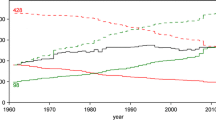Abstract
The Northern Territory of Australia has a unique situation of an extension larger than France and a population of 200,000, with only three meteorology stations open for more than 40 years, Darwin (DW), Alice Springs (AS) and Tennant Creek, and only two of them, DW and AS, providing data over 100 years, and from 500 to more than 1,000 km separating these stations and the stations in the neighbouring states of Australia. Homogenizations of data in between different measuring sites for the same location as well as the way to derive the missed data to complete at least 100 years from the neighbouring locations are analysed in details and the effects on the temperature trends are straightforwardly investigated. Using properly homogenised data over 130 years and a linear fitting, the warming maximum and minimum temperatures are +0.009 and +0.057 °C/10 years for Alice Springs and −0.025 and 0.064 °C/10 years for Darwin. With the data available, the only option to produce warming trends is to overweight the cold years in the middle of the 1970s and the subsequent return to warmer temperatures. Starting from 1980, to compute trends, there is still a clear warming in Alice Springs, but also clear cooling in Tennant Creek, and a mixed behaviour with warming maximum temperatures and cooling minimum temperatures in Darwin.





Similar content being viewed by others
References
Australian Government Bureau of Meteorology (2012) Australian climate variability & change—trend maps. http://www.bom.gov.au/cgi-bin/climate/change/trendmaps.cgi. Accessed 2 Feb 2012
Australian Government Bureau of Meteorology (2012) Long record temperature sites. http://www.bom.gov.au/climate/how/long_T_sites.csv. Accessed 2 Feb 2012
Australian Government Bureau of Meteorology (2012) Climate Data Online. http://www.bom.gov.au/climate/data/. Accessed 2 Feb 2012
Fujibe F (2011) Urban warming in Japanese cities and its relation to climate change monitoring. Int J Climatol 31:162–173
Santoso A, Sen Gupta A, England MH (2010) Genesis of Indian ocean mixed layer temperature anomalies: a heat budget analysis. J Clim 23:5375–5403
Hamdi R, Deckmyn A, Termonia P, Demarée GR, Baguis P, Vanhuysse S et al (2010) Effects of historical urbanization in the Brussels capital region on surface air temperature time series: a model study. J Appl Meteorol Climatol 48:2181–2196
Cheng F, Byun DW (2008) Application of high resolution land use and land cover data for atmospheric modeling in the Houston-Galveston metropolitan area, part I: meteorological simulation results. Atmos Environ 42:7795–7811
Pullen J, Holt T, Blumberg AF, Bornstein RD (2007) Atmospheric response to local upwelling in the vicinity of New York-New Jersey harbor. J Appl Meteorol Climatol 46:1031–1052
Holt T, Pullen J (2007) Urban canopy modeling of the New York City metropolitan area: a comparison and validation of single- and multilayer parameterizations. Mon Weather Rev 135:1906–1930
Brunetti M, Mangianti F, Maugeri M, Nanni T (2000) Urban heat island bias in Italian air temperature series. Nuovo Cimento Della Societa Italiana Di Fisica C 23:423–431
Brázdil R, Budíková M (1999) An urban bias in air temperature fluctuations at the Klementinum, Prague, the Czech Republic. Atmos Environ 33:4211–4217
Changnon SA (1999) A rare long record of deep soil temperatures defines temporal temperature changes and an urban heat island. Clim Chang 42:531–538
Panmao Z, Fumin R (1999) On changes of China's maximum and minimum temperatures in 1951–1990. Acta Meteorologica Sinica 13:278–290
Böhm R (1998) Urban bias in temperature time series—a case study for the city of Vienna, Austria. Clim Chang 38:113–128
Gray V (2011) The seven station series. Energy and Environment 22:424–434
Boretti A, Watson T (2011) Is New Zealand globally warming? Int J Glob Warming 3(3):219–231
Roderick ML, Farquhar GD (2004) Changes in Australian pan evaporation from 1970 to 2002. Int J Climatol 24:1077–1090
Morris CJG (2011) Urban heat islands and climate change—Melbourne, Australia. http://www.earthsci.unimelb.edu.au/~jon/WWW/uhi-melb.html. Accessed 22 May 2011
Melbourne as an Urban Heat Island (2011). http://mclean.ch/climate/Melbourne_UHI.htm. Accessed 22 May 2011
Morris CJG (2011) Urban heat islands in small towns—Deniliquin, Australia. http://www.earthsci.unimelb.edu.au/~jon/WWW/deniliquin.html. Accessed 22 May 2011
IPCC, Fourth Assessment Report: Climate Change, TS.3.1.1 Global Average Temperatures, 2007. http://www.ipcc.ch/publications_and_data/ar4/wg1/en/tssts-3-1-1.html. Accessed 10 Feb 2012
Author information
Authors and Affiliations
Corresponding author
Rights and permissions
About this article
Cite this article
Boretti, A. Statistical analysis of the temperature records for the Northern Territory of Australia. Theor Appl Climatol 114, 567–573 (2013). https://doi.org/10.1007/s00704-013-0859-3
Received:
Accepted:
Published:
Issue Date:
DOI: https://doi.org/10.1007/s00704-013-0859-3





